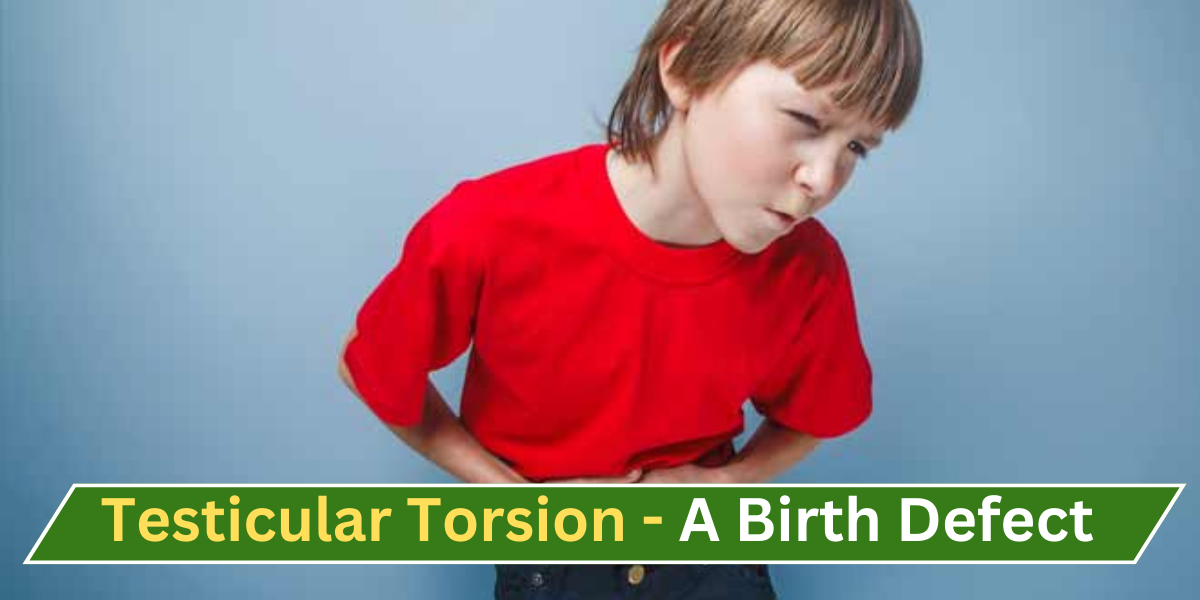Testicular torsion is a medical condition involving twisting the spermatic cord, which supports the testicles. This twist can result in a compromised blood supply to the testicle, leading to severe pain and potential long-term damage. While testicular torsion is a well-known emergency, there is confusion regarding its origin, with some people wondering if it is a birth defect. In this blog post, we will explore the intricacies of testicular torsion, its causes, symptoms, and, most importantly, whether it can be classified as a birth defect
What is a Testicuar Torsion?
Testicular torsion is a medical emergency that occurs when the spermatic cord, which provides blood flow to the testicles, twists, leading to reduced blood flow and potential damage to the testicle. While it can occur at any age, including in children, it is crucial to understand the unique aspects of testicular torsion in pediatric cases.
Symptoms of Testicular Torsion
Testicular torsion in children is a medical emergency that demands immediate attention. Early recognition and understanding of the diagnostic process are essential for preserving testicular function. The following is a detailed overview:
Sudden and Severe Pain
- Often, children who suffer from testicular torsion experience sudden and intense pain in the scrotum as a result of the condition.
- In addition to pain in the lower abdomen or groin area, the pain may also radiate to the lower back.
Swelling and redness
- The affected testicle might become swollen and appear larger compared to the other testicles.
- There may be redness or discoloration of the scrotal skin as a result of the infection.
Abdominal pain and nausea
- Children may complain of abdominal pain, which can accompany the scrotal pain.
- Vomiting may also occur, reflecting the severity of the condition.
Change in Testicle Position
- In some cases, parents may notice a change in the position of the testicle within the scrotum.
- The affected testicle may appear higher than usual.
Reluctance to Move or Walk
- Due to the pain, children with testicular torsion may be reluctant to move or walk.
- The discomfort can be severe enough to limit physical activity.
- Highlighting the sudden and intense pain experienced.
- Discussing other symptoms such as swelling and discoloration.
- The importance of seeking immediate medical attention.
Treatment Options for Testicular Torsion in Children
Testicular torsion in children is a surgical emergency that requires immediate intervention to restore blood flow to the affected testicle. The primary goal of treatment is to untwist the spermatic cord and secure the testicle to prevent future episodes. Here are the key treatment options:
Surgical Detorsion
- The most common and urgent treatment for testicular torsion in children is surgical detorsion.
- The procedure involves untwisting the spermatic cord to restore blood flow to the testicle.
- This can often be achieved through a small incision in the scrotum.
Testicular Fixation
- Following a successful detorsion, an orchiopexy may be performed to secure the testicle in its normal position within the scrotum.
- This involves fixing the testicle to the inner lining of the scrotum to prevent future episodes of torsion.
- Testicular fixation is typically recommended even if the testicle appears normal after detorsion to reduce the risk of recurrence.
Follow-up Care
- After surgery, children will require careful monitoring and follow-up appointments with a healthcare provider.
- Monitoring includes assessing the blood flow to the testicles and evaluating for any signs of complications.
Education and Prevention
- Parents and caregivers should be educated about the importance of recognizing symptoms early and seeking prompt medical attention.
- Pediatricians may discuss preventive measures with families, especially if there are anatomical factors or a family history that increases the child’s risk.
Birth Defects Defined
Birth defects, or congenital anomalies, are structural or functional abnormalities present at birth. These conditions can affect various parts of the body, ranging from mild to severe, and may impact the overall health, development, or functionality of the child. Birth defects can result from genetic factors, environmental exposures, or a combination of both.
Genetic Factors
Chromosomal Abnormalities
Alterations in the quantity or arrangement of chromosomes can lead to specific birth defects. For example, Down syndrome is characterized by an extra copy of chromosome 21.
Single-gene mutations
Some defects result from changes in a single gene. Single-gene mutations are responsible for the development of cystic fibrosis and sickle cell anemia.
Environmental Factors
Maternal Exposures
It’s important to know that exposure to certain substances during pregnancy, like drugs, alcohol, tobacco, or infections, can put the baby at risk of developing birth defects. For instance, if a pregnant woman is exposed to thalidomide, it can lead to limb abnormalities in the baby. So it’s crucial to stay away from such harmful substances during pregnancy to ensure the baby’s healthy development.
Nutritional Deficiencies
Not getting enough nutrients, especially in the early stages of pregnancy, can lead to birth defects. When there is a lack of folic acid, for instance, it has been linked to neural tube defects.
Conclusion:
In conclusion, while testicular torsion is a serious medical condition affecting the testicles, it does not fit the criteria of a birth defect. The origins of testicular torsion are primarily related to anatomical features and genetic factors rather than developmental anomalies during birth. Understanding the distinction between birth defects and conditions like testicular torsion is crucial for accurate information dissemination and can contribute to better awareness and prevention strategies for this emergency medical condition.


